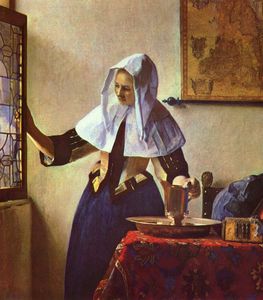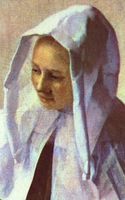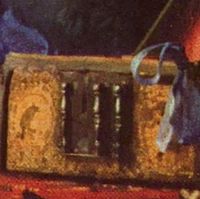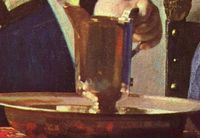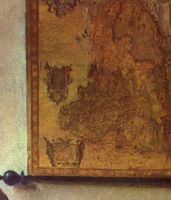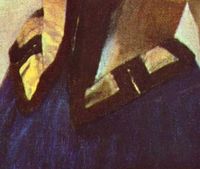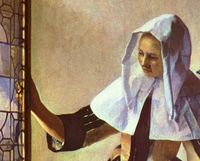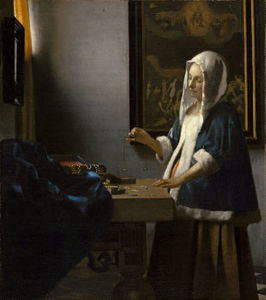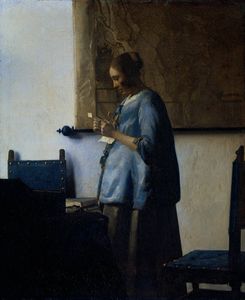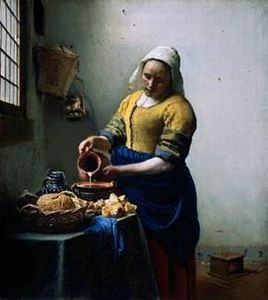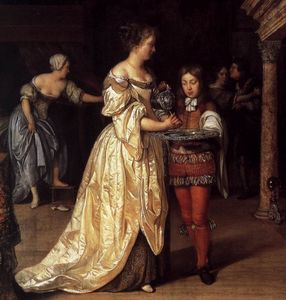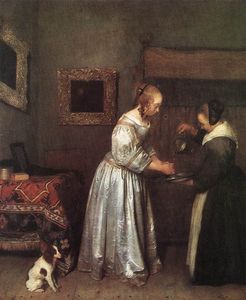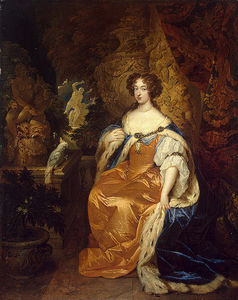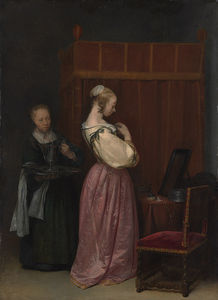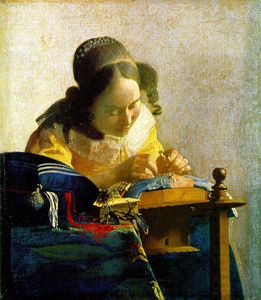Young Woman with a Water Pitcher
- Date of Creation:
- 1662
- Alternative Names:
- Woman with a Water Jug
- Height (cm):
- 45.70
- Length (cm):
- 40.60
- Medium:
- Oil
- Support:
- Canvas
- Subject:
- Figure
- Art Movement:
- Baroque
- Created by:
- Current Location:
- New York, New York
- Displayed at:
- Metropolitan Museum of Art
- Owner:
- Metropolitan Museum of Art
- Young Woman with a Water Pitcher Page's Content
- Story / Theme
- Analysis
- Critical Reception
- Related Paintings
- Artist
- Art Period
- Bibliography
Young Woman with a Water Pitcher Story / Theme
Young Woman with a Water Pitcher portrays an intimate moment in the household and it is an ideal image of domesticity in 17th century Dutch society. This is reaffirmed by the woman's headdress known as a 'hoofdoek' which was worn to protect the head in cold weather, to protect the hairstyle before public events and was also worn during a morning toilette.
The presence of a jewelry box on the right indicates that this room is a private one in which the woman is comfortable.
The model is believed to be Vermeer's wife Catharine or his eldest daughter, Maria, who bore a striking resemblance to her mother. Inventories made after Vermeer's death show that Catharine wore headdresses such as the one depicted here.
The woman in this scene is unique from other similar depictions by Vermeer because she is seen smiling softly, deep in thought and not completely consumed with the task in front of her. Young Woman with a Water Pitcher is an idealistic painting of a woman in an ideal home with an ideal life. The basin and water pitcher are recognized as traditional symbols of purity.
The objects in this image prove that the woman is from a wealthy upper or middle-class family. For example, the ornate jewelry box and its rich interior show that she has a fair accumulation of personal material wealth. Also, the rich eastern rug on the table was a very expensive possession at this time and was extremely very hard to come by.
The gilded pitcher also confirms the woman's social class. It is believed that this pitcher belonged to Vermeer's mother-in-law, Maria Thins, and it was also noted in inventories later on. A rare and valuable object, Vermeer expert John M. Montias claims that this gilded pitcher was most likely the one Maria gave to her daughter Catharine in one of her testaments.
The map of the Netherlands above the girl's head to the rights was a common decoration in Dutch households. It also demonstrates Vermeer's ideal of a united country and conveys a sense of Dutch pride. The map also promotes a triangular composition.
Young Woman with a Water Pitcher Analysis
Composition:
The light source from the left creates a triangular composition between the three main elements in the painting: the window, the map and the pitcher. This technique helps make the girl the central figure and focus of this piece.
Color Palette:
In this work we see, once again, Vermeer's abundant use of ultramarine. His unique use of ultramarine and black undertones creates a rich, dark midnight hue that can be clearly seen in the woman's dress, window and map rod.
Vermeer uses the ultramarine for reflective surfaces such as the window and even the glass shadows are cast in blue to reflect the intricate play of light on its smooth surface.
Chiaroscuro:
In this image Vermeer plays with aspects of optical illusion using his camera obscura. He plays not only with the light coming in from the window but also how it reflects as it fills the room on a horizontal plane and bounces off the pitcher.
Brushwork:
Delft was situated near a river as most of Netherland's cities were and so there was always a damp mist in the air. This technique was used to convey the brisk air entering the room after opening the window.
Young Woman with a Water Pitcher Critical Reception
In 'Vermeer and the Dutch Interior' Alejandro Vergara says,
"This tranquil scene, notable for the simplicity of the forms which define the composition and the relationship between the different shades of red, blue and ochre, presents an idealized vision of feminine virtue and is an excellent example of Vermeer's exquisite sensitivity in the observation of reality.
Vermeer's mastery lies in the way he makes the formal structure of the work correspond to the serenity of the subject matter, allowing the spectator to discover the harmony and beauty beneath the chance events of everyday existence. To achieve this, the details are extremely important, such as the cadence created by the lines of the woman's arms and her amiable expression which contribute to the warmth and sensation of restraint which the scene conveys. The artist's care in the design of the composition led him to make changes (right above) as he worked on it beneath her right elbow are traces of a chair, which Vermeer subsequently decided to move back to the wall behind the table."
Young Woman with a Water Pitcher Related Paintings
Young Woman with a Water Pitcher Artist
Vermeer was a realist painter who focused on chiaroscuro and became a master of this technique. He delighted in the technicalities of the camera obscura and was an avid fan of using various lens and glass contraptions to discover new forms of capturing light in various contexts which can be seen in Young Woman with a Water Pitcher.
Although Vermeer held nothing original in his artistic interpretation and subject matter, he was extremely skilled in creating superb pieces of art. Vermeer does not create a specific narrative in his works like his contemporaries but rather concentrates on the moment itself and the rest of the story is created by the observer.
The artist created numerous paintings of women during his career but the woman in this scene is unique because she is smiling softly and not solely concentrating on the task in hand. This is a very idealistic canvas and one that reflects Vermeer's thoughts and hopes for Dutch society.
Young Woman with a Water Pitcher Art Period
Dutch Baroque has become the most noted era in art and it was the most lavish style in the history of Europe's figurative arts. Artists were able to freely choose their subject matter and how they wanted to express it and this resulted in artist excelling in creating new art styles and techniques.
Baroque art came into play at a time when the foundations of capitalism were being laid by the world's growing economies and art was expanding in new and exciting directions.
New national schools were opening across Europe but there was already a dominate style, spearheaded by great masters, such as Caravaggio, Poussin, Bernini and Rubens who provided inspiration for many emerging artists.
Vermeer was an idealist who strived to bring out the beauty in the most mundane aspects of daily life and his unique skill made him a leader and revolutionary of the Baroque era.
Young Woman with a Water Pitcher Bibliography
To read more about Vermeer and his work please refer to the recommended reading list below.
• Arasse, Daniel. Vermeer: Faith in Painting. Princeton University Press, 1996
• Binstock, Benjamin. Vermeer's Family Secrets: Genius, Discovery, and the Unknown Apprentice. Routledge, 2008
• Cant, Serena. Vermeer and His World: 1632-1675. Quercus, 2009
• Liedtke, W. Vermeer and the Delft School (Metropolitan Museum of Art). Yale University Press, 2001
• Snow, E. A Study of Vermeer. University of California Press, 1994

